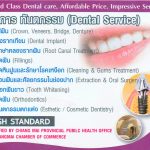
Gum Disease – Treatment Overview
Early treatment of gum disease is very important. The goals of treatment are to prevent gum disease from permanently damaging tissues, control infection, and prevent tooth loss. For treatment to be effective, you will need to:
- Keep your teeth clean by brushing two times a day and flossing one time a day.
- See your dentist regularly for checkups and cleanings.
- Avoid all tobacco use. Tobacco decreases your ability to fight infection, interferes with healing, and makes you more likely to have serious gum disease that results in tooth loss.
Treatment for early-stage gum disease
If you have early-stage gum disease (gingivitis ), you may be able to reverse the damage to your gums:
- Brush your teeth two times a day, in the morning and before bedtime.
- Floss your teeth one time a day.
- Use an antiseptic mouthwash, such as Listerine, or an antiplaque mouthwash.
For more information on how to care for your teeth, see:Dental care: Brushing and flossing your teeth.
Your dentist will want to see you for regular checkups and cleanings. Professional cleaning can remove plaque and tartar that brushing and flossing missed. After you have had gum disease, you may need to see your dentist every 3 or 4 months for follow-up.
Your dentist may prescribe antibiotics to help fight the infection. They can be applied directly on the gums, swallowed as pills or capsules, or swished around in your teeth as mouthwash. Your dentist may also recommend an antibacterial toothpaste that reduces plaque and gingivitis when used regularly.
Treatment for advanced gum disease
Early-stage gum disease (gingivitis ) that is not treated promptly or that does not respond to treatment can progress to advanced gum disease (periodontitis ). Periodontitis requires prompt treatment to get rid of the infection and stop damage to the teeth and gums, followed by long-term care to maintain the health of your mouth.
- Your dentist or dental hygienist will remove the plaque and tartar both above and below your gum line. This procedure, called root planing and scaling, makes it harder for plaque to stick to the teeth.
- Your dentist may give you antibiotics to kill bacteria and stop the infection. They may be applied directly on the gums, swallowed as pills or capsules, or inserted into the pockets in your gums.
- You may need surgery if these treatments don”t control the infection or if you already have severe damage to your gums or teeth. Surgery options may include:
– Gingivectomy, which removes and reshapes loose, diseased gum tissue to get rid of the pockets between the teeth and gums where plaque can build up.– A flap procedure, which cleans the roots of a tooth and repairs bone damage.– Extraction, to remove loose or severely damaged teeth. - After surgery, you may need to take antibiotics or other medicines to aid healing and prevent infection.
After treatment, you will need to keep your mouth disease-free by preventing plaque buildup. You will need to brush carefully and thoroughly after all meals and snacks and floss daily. Your dentist will probably prescribe an antibacterial mouthwash.
Your dentist will schedule follow-up appointments regularly for cleaning and to make sure that the disease has not returned.



